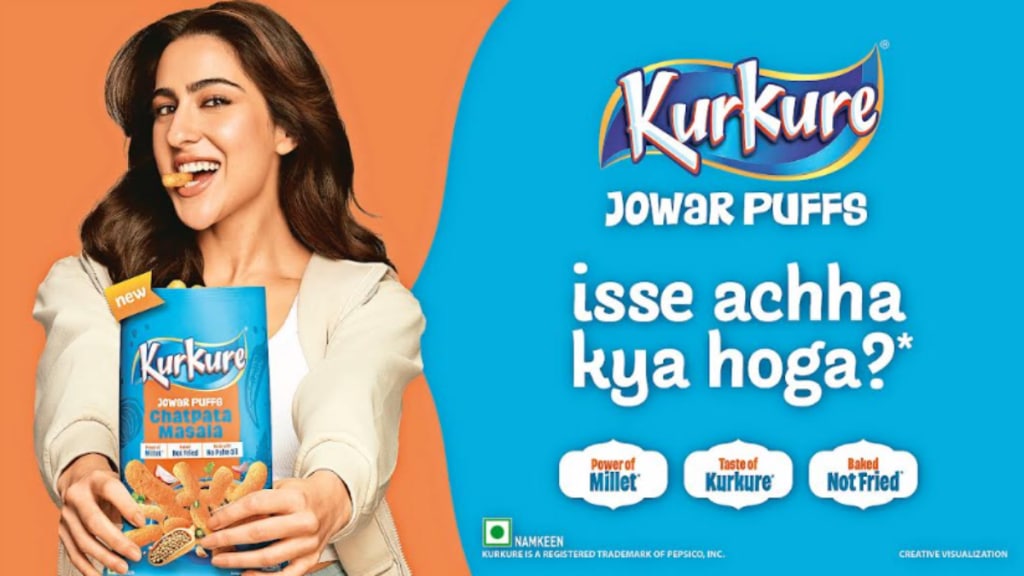For a quarter of a century, Kurkure has been a shorthand for indulgence. With its tangy crunch and irreverent positioning, PepsiCo India’s local innovation became a 1,000-crore brand and one of the mainstays of its 6,889-crore snacks business in CY24. Kurkure was never sold as “good-for-you”; it is everything that is fun, bold and chatpata.
That is why its newest variant marks a shift worth watching. Kurkure has now released a version reformulated with jowar, one of India’s traditional millets. The move places the brand bang in the middle of the debate shaping the future of snacking in India. But the question is, how far can mass indulgence stretch toward health without diluting its core idea of guilt-free gratification?
“This is not a departure, but an addition,” says Aastha Bhasin, category lead–Kurkure, PepsiCo India. “We are offering something that covers the spectrum from indulgent to mindful. The new innovation with jowar is not set to change the core of who we are.”
The launch is supported by a national campaign featuring Sara Ali Khan, built on the line “Isse achha kya hoga”. Unlike typical health-positioned snacks, Kurkure’s millet version does not excessively highlight calorie count or nutrition value. Instead, the strategy is to wriggle into Kurkure’s chatpata territory rather than turning the brand into a pure-play wellness offering.
The millet wave
PepsiCo’s move fits in perfectly with the Indian consumers’ growing appetite for healthier snacking. The millet snacks market in India is valued at around `5,000 crore and is growing at over 17-20% annually, according to Arun Nagpal, co-founder and director, Mrida Group. “Growth will be driven by brand activities and new offerings that get popular,” says Santosh Sreedhar, partner, Avalon Consulting.
There is a legacy of millet consumption in Indian households, and startups were among the early movers in the new millet race. But penetration of millet-based foods remains uneven. “In our own data, Tier-1 and Tier-2 cities drive the bulk of sales. But we’re also seeing encouraging signs in semi-urban clusters once we hit the sweet-spot price points (10–20 trial packs) and place products in kiranas. Rural FMCG growth is now outpacing urban in many categories, so the next big wave will come from Tier-3 towns as awareness and distribution catch up,” notes Atul Gupta, founder & CEO, Bonvie Snacks.
FMCG players follow
Large FMCG players have also thrown their hats into the ring. ITC has launched millet versions across its portfolio under its “Mission Millet” initiative. “It’s a gradual incorporation,” says Shuvadip Banerjee, chief digital officer, ITC Foods. The task for the company is to reestablish the credentials of millets as part of the everyday basket.
For PepsiCo, the challenge is not just timing but brand architecture. The challenge would be to integrate health in a way that feels seamless, says Ambika Sharma, founder and MD, Pulp Strategy, so the product is deemed “permissible indulgence”. Snacks must satisfy taste cravings while signalling some functional benefit such as less guilt, more goodness, or, in this case, millets. “Positioning the product as a ‘smarter indulgence’ rather than a ‘health snack’ helps preserve the brand’s playful appeal while reinforcing its relevance in a more health-conscious consumer landscape,” argues N Chandramouli, CEO, TRA Research.
That coexistence is becoming a consumer expectation. “Snacking in India has always been defined by three dimensions: health, heritage, and mass reach,” says Rituparna Basu, professor-marketing, IMI Kolkata. “Health is becoming non-negotiable.”
Much will depend on how the health benefits are communicated. “Humour, quirky packaging, and digital storytelling can highlight benefits in an entertaining way,” says Yasin Hamidani, director, Media Care Brand Solutions.
